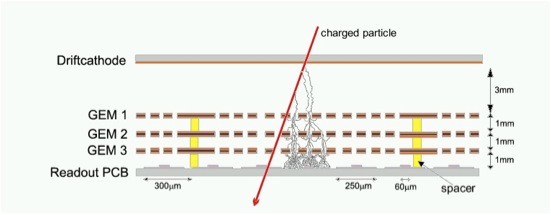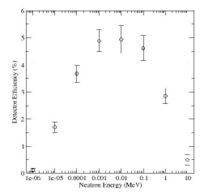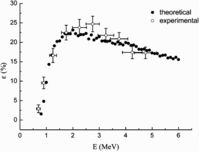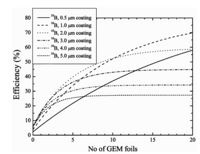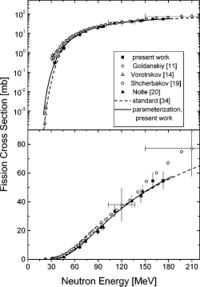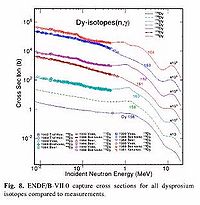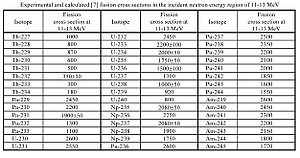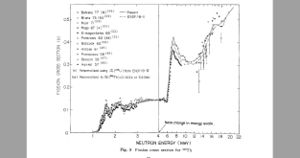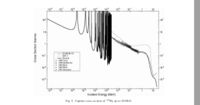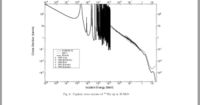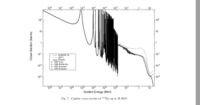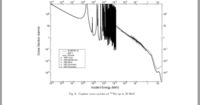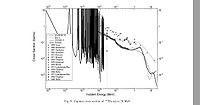Neutron TGEM Detector Abdel
Haithem's logbook for developing neutron sensitive TGEM detector
1/23/09
image
1.) Search the web for patent which coats GEM detector with neutron sensitive materials. I think it is for Thermal neutrons.
Materials of high neutron capture cross section are studied widely, an example is the following patent
[[1]]
Most of the high neutron capture cross section materials were measured for different neutron energies. A comprehensive work is published in 2000. The project was supported by Korea Atomic Energy Research Institute and Brookhaven National Laboratory [[2]]
U-235 is the one of the best choices since it has a high neutron fission cross section and a long half life compared to other the other isotopes that may come under choice.
A second choice is Th-238 and U-238 which have fission cross section less than that of U-235 but still good for our experiment.[[3]]
A boron coated GEM foil is being made by the company below http://n-cdt.com/
Another method uses BF3.
We are interested in a fissionable material coated onto the copper foils that is thin enough to allow the fission fragments to escape the foil and ionize the gas in the detector.
2.) Search for companies which use either sputtering or coating technology to apply the above material to caopper PCboards with hole int them such that the material does not fill up the hole. Hole diameter = ?
The material sputter onto the copper would have thickness on the order of Angstroms.
The TGEM PCboard would have a surface area of 10 cm x 10 cm.
3.) Current neutron efficiency plots for several detector
Media:NeutronDetectionEfficiency-vs-Energy_Ne-213_BaF.pdf
1/30/09
1.) Investigate if Thorium Oxide will be a good candidate for the fission chamber. You would use electrolysis to coat a TGEM board.
Ways to make thorium fission chamber
2.) Find reference for THGEM9, this was used to determine optimal THGEM design 2 years ago
GEM-copper plate has dimensions of 3X3cm or 10X10cm with thinkness 5 micrometer copper layers.It has holes with diameter 60-80 micrometer.(From Operation of a triple GEM detector with CsI photocathode in pure BF4)
2/6/09
Thin deposition ThO2 molecular plating
2/13/09
Check if the people below can deliver Th coated Al or Cu sheets , coating thickness smaller than 5 micron, the thinner the better. http://www-wnt.gsi.de/tasca/
2/20/09
2.5 x 2.5 cm thorium coated TGEM cards coated by ISU chemistry.
chemistry Department cant not do the sputtering for safety purposes, they like to avoid radiation contamination.
Need a mask for the predrilled TGEM cards to prevent Thorium from entering holes
Radioactive waste procedure if we are allowed to sputter in chemistry.
Write report describing the process we want to do.
Radioactiving of Thorium may be a stumbling blog because of waste generated.
If we go for non-radioactive materials look up fission X-sect for Bismuth and Dysprosium
Fission cross section for Bi starts to be effective when the neutron energy is more than the range of interest.
Dy-isotopes are very good for absorbing neutrons in the range between 0.01- 10 MeV.
Media:Zaidi_RadChem_vol93_2005.pdf
2/27/09
1.) Dysprosium (Dy) makes a lot of gammas and maybe 100 less alphas
2.) Don't give up trying to make thorium coated materials
try to send e-mail to one of these authors
N. Takahashi, Zeitschrift für Physik A Hadrons and Nuclei Volume 353, Number 1 / March, 1995
3.) Fission cross-section n,f for Tb
3/13/09
1.) look for a company that does resistive evaporative coatings
This company sells the machine http://www.lesker.com/newweb/Deposition_Sources/ThermalEvaporationSources_Resistive.cfm
2.)(n,f) X-sect for Dysprosium (Dy) ?
3.) Thorium and thorium oxide thin films (19 to 61 nm thick) were RF-sputtered onto mirrors. RF sputtering onto copper plates?
The neutron fission cross sections of 92235U and 92238U between 0.3 and 12.5 MeV W W Osterhage et al 1978 J. Phys. G: Nucl. Phys. 4 587-595
http://www.inf.uu.se/Reports/publications.html
Neutron-induced fission cross sections of natPb and 197Au in the 45-180 MeV region, V.P. Eismont, A.V. Prokofiev, A.N. Smirnov, S.M. Soloviev, H. Condé, K. Elmgren, N. Olsson and P.-U. Renberg Conference Proc. ADTTA99, 1999, (in press).
Up-to-date status and problems of the experimental nucleon-induced fission cross section data base at intermediate energies, V.P. Eismont, A.V. Prokofiev, A.N. Smirnov, I.V. Ryzhov, G.A. Tutin, H. Cond, K. Elmgren, N. Olsson and P.-U. Renberg, Proc. ADTTA99, 1999, (in press).
Neutron-induced fission cross section ratios of 209Bi and 238U at 75 and 96 MeV, V.P. Eismont, A.V. Kireev, I.V. Ryzhov, S.M. Soloviev, G.A. Tutin, H. Condé, K. Elmgren, N. Olsson and P.-U. Renberg, Proc. ADTTA99, 1999, (in press).
Neutron-induced fission fragment angular distribution of 238U at 96 MeV, V.P. Eismont, A.V. Kireev, I.V. Ryzhov, S.M. Soloviev, G.A. Tutin, H. Condé, K. Elmgren, N. Olsson and P.-U. Renberg Proc. ADTTA99, 1999, (in press).
Measurements of neutron-induced fission cross sections of heavy nuclei in the intermediate energy region, V.P. Eismont, A.V. Prokofyev, A.N. Smirnov, K. Elmgren, J. Blomgren, H. Condé, J. Nilsson, N. Olsson and E. Ramström, Accelerator-Driven Transmutation Technologies and Applications, Kalmar, ed. H. Condé (Uppsala: Uppsala University, 1997) p 606-612.
4/2/09
Summury of events through the last two weeks:
1- Looking for a neutron fission cross section for Dyspromium.
2- Looking for other possile elements that can be sued beside our choices for Thorium and Dysprosium.
these elemets should have a high neutron cross for fission (n,f),(n,gamma),(n,p) or (n,alpha).
3- Using Neutrons cross sections (by D. Hughes and R. Schwartz, 2nd edition, 1957) as comphensive reference for our choice.
Comparison between Thorium and Dysprosium
.
Thorium: chacterized by relatively high neutron fission cross for both of its isotopes (Th-232 nad Th-230) compared to the stable elements but it is one of low fission cross sections compared to radioctive actinides. A lot of efforts are spent even in coating or finding the appropriate place or group to do that, since most of people are totally disencouraged to coat radioctive elements.
Dysprosium: radioactively stable,it has 5 isotopes Dy-160, 161, 162, 163 and 164. It is one of the best elements for detecting the neutrons because of high neutron capture cross section in the energy range of interest.
Also dysprosium pulls out alpha paticles (σ(n,α)= 3.6 mb at 14.2 MeV).
Other Possible Elements
. Generally,the highest values for neutron cross sections (σ(n,f), σ(n,p), σ(n,γ) and σ(n,α)) are for radioactive isotopes, which are not desirable for coating. Fortunately, there are non- radioactive elements have a relatively high neutron cross sections, for example:
σ(n,γ) at 0.025 MeV (in mb): Gd-158(710(70)), Sm-152 (670(100)), Br-81 (550(55)), Sm-154 (530(70)), Ce-142 (425(45)),
Hf-180(440(70)), Ru-96(320(60)), Ru-102 (390(40)), W-186 (300(40)), Zr-96 (240(40)), Hg-202(57(13))
σ(n,γ) at 1 MeV (in mb): Re-185(180), (390(40)), Ru-102 (30), Ru-104 (31), Hg-204(100), Br-81 (17)
σ(n,γ) at 14.5 MeV (in mb): Gd-160 (19(5)), Zr-96 (<4),
| Element | X-sect (mb) |
| Re-185 | 180 |
| Ru-102 | 390 |
4/3/09
1.) Derive equations for voltages at each GEM stage and the net current for our voltage network and check them with measured values for the 4kV version of the voltage network.
2.) Reference [J.C. hadler, Radiation Measurements Vol 43 (2008) pf S334-S336] says
- R = 14 \mu m = mean range of fission fragment6s in U_3 O_8
- R= 12 um for UO_3
- 0.1 um thickness U( Th) will reduce mean length of fission tracks by 2%
3.) Plot N -vs- d using Equation 2 of Reference [J.C. hadler, Radiation Measurements Vol 43 (2008) pf S334 The number of particles per unit area is given by the equation:
d : the thickness in (um)
The range of the fragments in the emulsion is 12.07 um
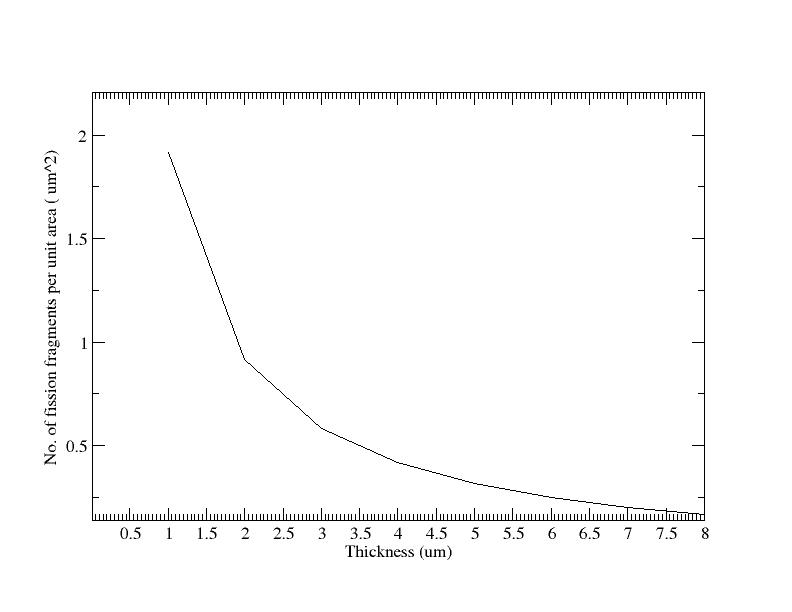
4/17/09
A call conference with Dr.Wolfe, As result, the following is considered as next step for the project:
1- Check the melting temperature that a PC boeard can hold ( the size of the chamber can hold the 10 X 10 PC board ).
2- Checking from a vender for chunk bulk ThF4 with size min. 30 cc.
3- Checking the thermal properties of ThF4 specially the melting point and if Thorium is adhere to copper in that temperature.
4- A mask should be prepared from stainless steal (Al is not preferable),inaddtion to thinking of drilling process and who
is going to do it.
5- Dr. Forest is going to send the email after collecting all the information needed to Dr. Wolfe.
Coaing process is going to be by electron beam, thorium should be heated to 1750 C. (the melting point for pure Th).
Until this point the uniformty of the surface is an important factor, but I think it would be important whenever we start thinking of the track and its direction for Th fission fragments.
References
Voss and 3 russian references for Dy(n,x) cross sections
Media:Shalem_MSthesis_march2005.pdf
http://arxiv.org/abs/0903.3819 Dy photon gammas spectrum
http://www.ippe.obninsk.ru/podr/cjd/kobra13.php?SubentID=30974002
http://www.americanelements.com/thoxst.html
http://arxiv.org/pdf/physics/0404119
File:NIM A590 2008 pg134 Eberhardt.pdf Prep Targets
Neutron cross sections for different elements Media:Neutron_cross_sections.pdf
http://www-nds.iaea.org/RIPL-2/
Media:n gamma cross sections at 25 keV.jpg
Media:n alpha cross section at 14.2 MeV.jpg
Media:ne cross section at 14 MeV.jpg
Media:high enegy fission x-section.jpg
Media:N_gamma_x-section_at_400_keV.jpg
Media:x-sections of reactions at 14 MeV.jpg
Media:n p x-section at 14.3MeV.jpg
Media: n gamma x-section at 14.5 MeV.jpg
Media: elastic x-section at 0.5 MeV.jpg
Media: n gamma x-section at 1 MeV.jpg
Media: n 2n x-section at 14.3 MeV.jpg
Donald James Hughes, Neutron cross sections, 2nd edition 1958, u.s.a atomic energy commission.Media:Neutron cross sections.pdf
File:NSAE 151 2005 319-334 Y.D. Lee.pdf
12 Volt power supply system.
http://www.lnf.infn.it/esperimenti/imagem/doc/NIMA_46128.pdf
